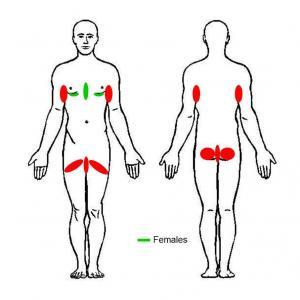Symptoms
HS is characterised by painful, leaking lumps that may come and go. These lumps can fill with pus and become painful and sore. Eventually, the lumps rupture and leak the contents (which can have a foul odour) onto the surrounding skin and clothing. In time (days, weeks, months, or longer), these lumps can fill again and the cycle repeats.
In early HS, there are usually a mixture of blackheads, spots, or red lumps which look like boils. In the later stages of HS, tunnels may form under the skin that leak pus with wounds that may not heal easily. Over time, more scarring may appear.
HS typically appears where skin meets skin and is most often found in the following areas:
- Armpits
- Breasts
- Genitals
- Inner thighs
- Backside/buttocks
- The area between the backside/buttocks and the genitals
Although less common than the body locations listed above, HS can appear in other areas too such as the ears, or around the belly. Rarely, HS can appear on the the back, face, or neck.
Click on the symptoms below for further detail.

Image source: https://ehsf.eu/hidradenitis-suppurativa/
Physical Symptoms
Diagnostic Delay
HS is often misdiagnosed. Studies have shown that on average, it takes 7 – 10 years for someone to learn they have HS.
- A 2020 global study1 involving almost 1300 people from four continents, reported an average diagnostic delay of 10.2 years.
- In Ireland, an average delay of approximately 8.4 years has been reported2.
The delay can have large impact on the person with HS and their families, healthcare, and society.
References:
1. Garg A, et al. Evaluating patients’ unmet needs in hidradenitis suppurativa: Results from the Global Survey Of Impact and Healthcare Needs (VOICE) Project. J Am Acad Dermatol. 2020 Feb;82(2):366-376. doi: 10.1016/j.jaad.2019.06.1301. Click here to see more.
2. Delany E, et al. A cross-sectional epidemiological study of hidradenitis suppurativa in an Irish population (SHIP). J Eur Acad Dermatol Venereol. 2018 Mar;32(3):467-473. doi: 10.1111/jdv.14686. Click here to see more.

Image source: https://skin.science/skin-story/hidradenitis-suppurativa
More detailed information can be found at the following sources
The Stages of HS
HS is usually classified into three stages called Hurley staging, named after the surgeon who proposed it.1

Hurley Stage I
This may be a single lesion without sinus tract (tunnel) formation.

Hurley Stage II
Single or multiple lesions, but with limited tunneling.

Hurley Stage III
Multiple lesions, with more extensive tunnels and scarring. It involves an entire area of the body
Images source:2
HS severity is divided into three stages, with the least severe being Hurley stage I, and the more severe being Hurley stage III.
Hurley staging allows doctors to assign a severity level to HS, but it does not account for other factors such as disease activity, the pain, or the impact on a person’s quality-of-life. As a result, many different measurements/tools have been developed to assess HS severity to account for these additional factors.
Currently, there are > 30 severity assessment measurements/tools in use but most doctors still refer to and use the Hurley staging system.
References:
1. Hurley HJ. Axillary hyperhidrosis, apocrine bromhidrosis, hidradenitis suppurativa, and familial benign pemphigus: surgical approach. In: Roenigk RK, Roenigk HH Jr, eds. Dermatologic surgery: principles and practice. 2nd ed. New York: Marcel Dekker, 1996:623-45.
2. Jemec GB. Hidradenitis suppurativa. J Cutan Med Surg. 2003 Jan-Feb;7(1):47-56. doi: 10.1007/s10227-002-2104-z.
